The Economics and Statistics Division maintains archives of previous publications for accountability purposes, but makes no updates to keep these documents current with the latest data revisions from Statistics Canada. As a result, information in older documents may not be accurate. Please exercise caution when referring to older documents. For the latest information and historical data, please contact the individual listed to the right.
<--- Return to Archive
For additional information relating to this article, please contact:
November 30, 2022CENSUS EDUCATION AND LABOUR, 2021 Statistics Canada has released results for education and labour from the 2021 Census.
Among those aged 25-64, 10.0% of Nova Scotians reported having no educational certificate, degree or diploma (similar to the national average). College (24.7%) and high school (24.4%) were most commonly reported as the highest level of education achieved by Nova Scotians - accounting for nearly half of the population aged 25-64 (above the national average). University bachelor's degrees (19.7%) were also frequently cited as the highest level of education, though at a lower share than the national average. Nova Scotians report a lower share than the national average at all levels of university education as well as apprenticeship/trade certificates.
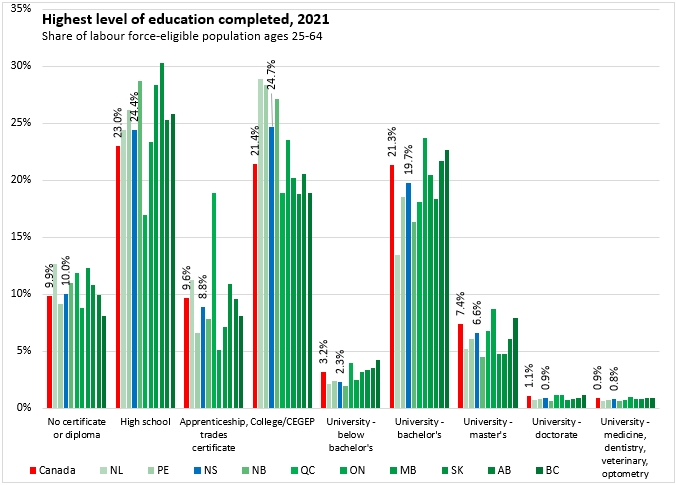
The highest level of education has a significant impact on labour market outcomes. Those with university education report the highest participation rates, at least 30 percentage points higher than those without a certificate or diploma. Employment rates for those with apprenticeship/trades certification, college diplomas/certificates and university certificates below a bachelor's level reported somewhat lower participation rates. High school graduates reported even lower participation rates (though still 16 percentage points higher than those with no certificate or diploma).
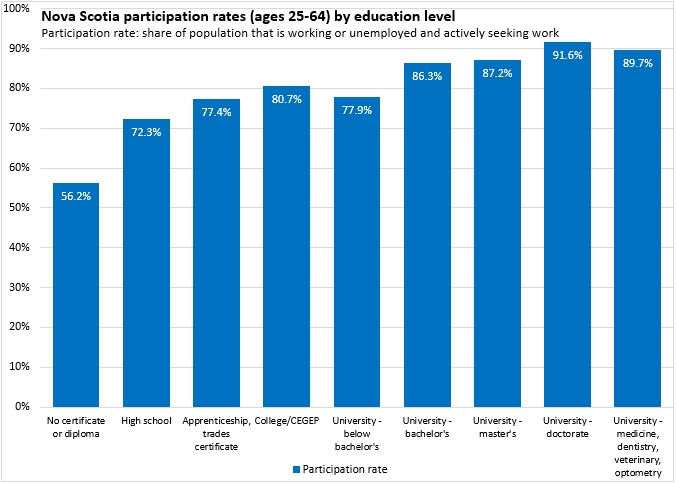
The gap in employment rates between those with a university education and those without a certificate or degree is even wider than the gap in participation rates. There was also a more sizable gap in employment rates between university graduates at the bachelor's level or higher and those with post-secondary certifications though colleges, apprenticeship/trades and university certificates below a bachelor's level.
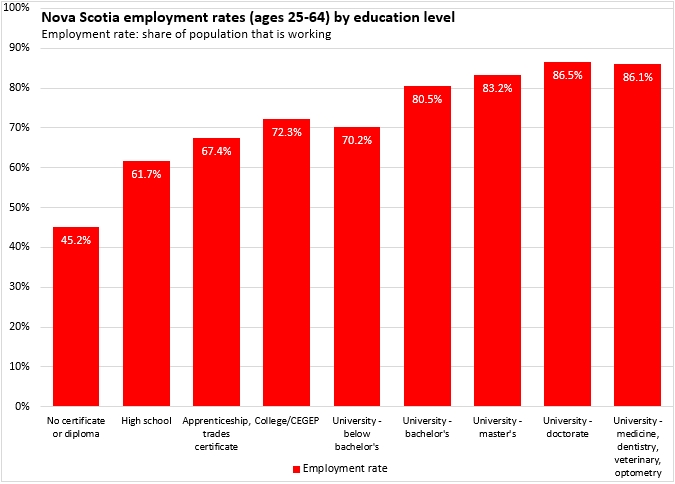
Unemployment rates were notably higher for those with no educational certificate or diploma (19.6%) as well as those with a high school (14.6%) or apprenticeship/trades certificate (13.0%). Unemployment rates were lower for those with a university degree - particularly above the bachelor's level.
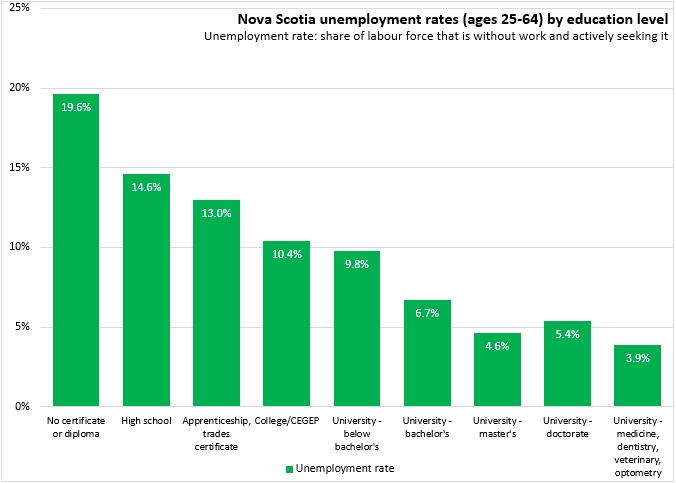
Including those with no certification and those with only a high school diploma, 34.4% of Nova Scotians age 25-64 have not studied in specialized post-secondary field of study. Among those with post secondary specialization, the most common subject areas were: management/public administration, architecture/engineering (including related technologies), health and social sciences/law.

Employment rates for those with specialized post-secondary education were generally higher than employment rates for those with no postsecondary degree or certificate. Employment rates were highest in a specific field for those who studied math/computer science and lowest for those who studied in personal/protective/transportation services.
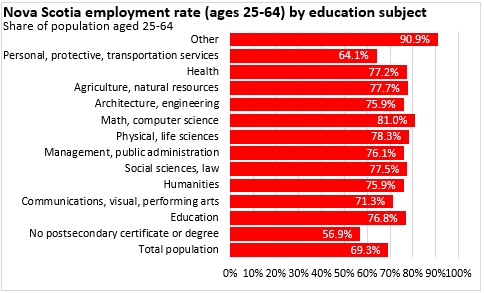
Not including the small number of Nova Scotians whose field of study was 'other', those with post secondary studies in visual arts/performing arts/communications reported the highest unemployment rates while those who specialized in education and health had the lowest unemployment rates.
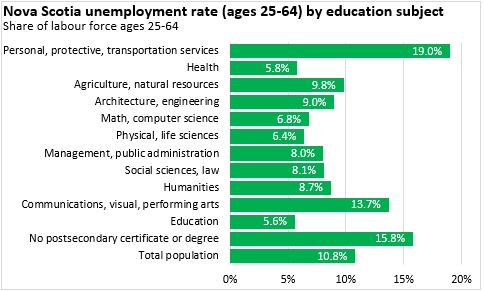
Average incomes among those aged 25-54 generally rise with higher educational credentials. In Nova Scotia, those with a bachelor's degree or higher report more than twice the earnings ($66,200) than those with no certificate or diploma ($32,080).
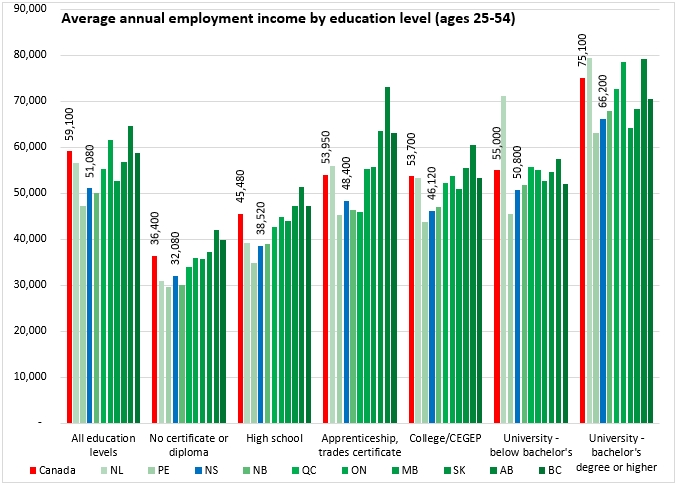
The average earnings of women in Nova Scotia were 76.8% of the average earnings of men. This earnings gap was widest for those with apprenticeship/trades certificates (55.9%) as well as those with no certificate or diploma (60.2%). The gap was narrowest for those with a university degree (78.0%).
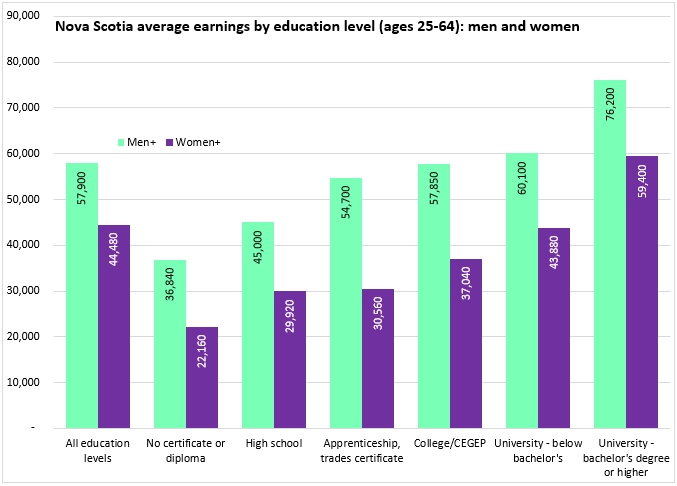
Across Nova Scotia, 64.7% of those aged 25-64 reported working full year, full-time. This was higher than the national average and just below the highest shares in Manitoba (65.0%) and Ontario (64.8%). Nova Scotia also reported below average prevalence of part time and/or part year work at 31.3%. 3.9% of Nova Scotians aged 25-64 reported not working at all.

Among counties in Nova Scotia, full-year full-time work was most prevalent in Halifax as well as its surrounding counties (Hants, Lunenburg, Colchester, Cumberland, Pictou). Part year and/or part-time work was more prevalent in Shelburne, Victoria and Guysborough counties. Shelburne county also reported the highest portion of the population aged 25-64 that did not work at all.
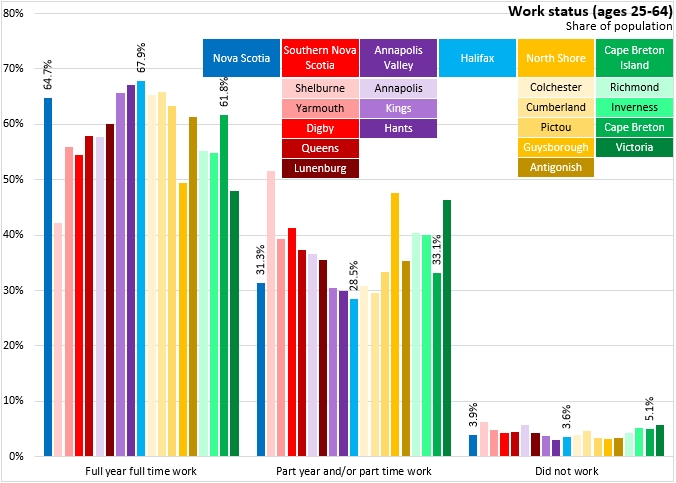
Source:
Statistics Canada.
Table 98-10-0445-01 Labour force status by major field of study, highest level of education, location of study compared with location of residence, age and gender: Canada, provinces and territories, census metropolitan areas and census agglomerations with parts;
Table 98-10-0453-01 Job permanency by highest level of education, occupation major group, employment income statistics, age and gender: Canada, provinces and territories, census metropolitan areas and census agglomerations with parts
<--- Return to Archive